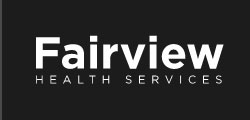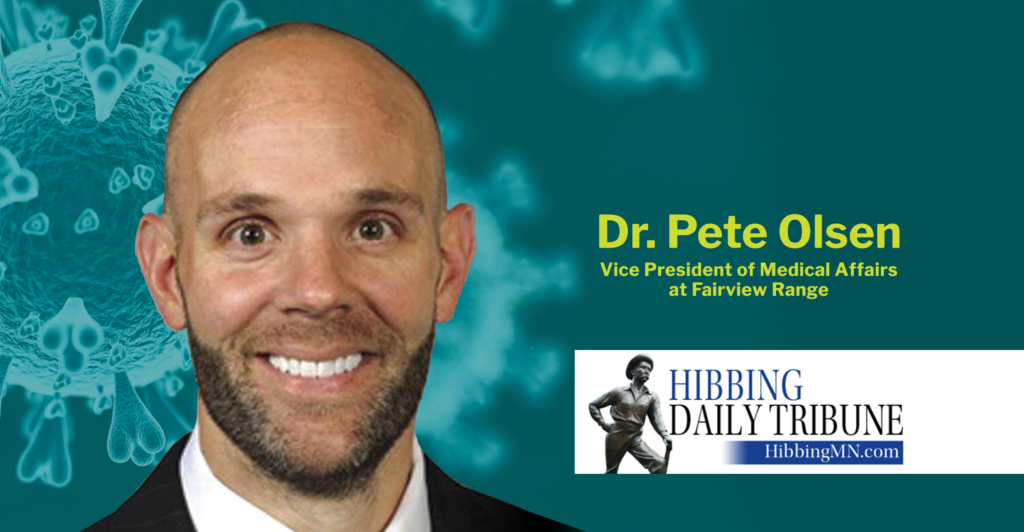Dr. Olsen of Fairview Range was recently interviewed by the Hibbing Daily Tribune. They have graciously allowed us to repurpose that discussion into an article for our healthcare community.
This interview was originally published in the Hibbing Daily Tribune on May 17, 2020.
As the coronavirus spreads across Minnesota, health officials are urging citizens to wear masks and practice social distancing in public. Over the past two months, hospitals have increased supplies of ventilators and sought out additional intensive care unit beds in the instances of patient overflow.
Most of the COVID-19 cases in the state are centralized in metro areas, but the virus has infiltrated rural regions, in settings with large populations per capita of older adults with underlying health conditions. As of Saturday, St. Louis County had 101 cases of the coronavirus and 12-related deaths. In the past two weeks, the Dairy Queen in Ely and the L&M Fleet Supply and Super One Foods stores in Hibbing have confirmed employees testing positive. The Emeralds nursing home in neighboring Grand Rapids has reported at least 18 cases.
Though the cases only recently arrived in the northern part of the state, doctors, nurses and staff at rural medical facilities have been working countless hours in preparation of the possible influx of patients.
Here, the Hibbing Daily Tribune offers an interview with Dr. Pete Olsen, who has been on the front lines at Fairview Range in Hibbing. The transcript has been slightly edited for brevity and clarification.
HDT: Can you kind of tell us who you are and what your role is at Fairview Range?
Dr. Olsen: I’m a family physician who trained at the University of Minnesota. I spend part of my time providing clinical care to patients in the emergency department and the rest serving as the Vice President of Medical Affairs.
HDT: Talk to me about how Fairview Range has adapted to Covid-19?
Dr. Olsen: In addition to the way we mask, gown and glove to provide care to each patient, we have adapted the way we clean, how we direct patient flow and even how employees enter the facility. For example, all employees enter through a common door where screeners have the opportunity to confirm no one is arriving to work ill. Patients also have a common entrance through the north side of the building as well as the clinic entrance where we have continued to provide essential care. Within Fairview Range, we cohort patients based on CDC guidelines to decrease the risk of disease transmission once patients are admitted. In fact, we have an entire nine bed unit devoted to Persons Under Investigation (PUI) for COVID.
HDT: Can you help me understand what it looks like in Fairview Range and how you’re expanding the capacity of beds and PPE?
Dr. Olsen: There have been many changes as we’ve adapted under the COVID pandemic. Before COVID, we already had the capacity to serve our community well, including a number of ICU resources to provide critical care. We have a privilege to have a robust behavioral health service in Hibbing, which is unique for a rural community. Through our coordination with M Health Fairview, we are able to closely align with the guidelines from the Centers for Disease Control and the Minnesota Department of Health. This allows us to provide the same testing and initial treatment to patients they would receive in a larger metropolitan area. If a patient’s illness begins to advance beyond the resources we can provide, our partnership with M Health Fairview allows for immediate consultation with critical care specialists as well as several transfer options depending on the needs of the patients. We’ve made structural changes to the facility to create additional negative flow air rooms that allow staff to be safer as they provide care to patients and to reduce the risk of disease transmission. These rooms have multiple air changes each hour to safely filter and turnover the air in a treatment room and this significantly reduces the risk from viruses and other infectious pathogens. Personal Protective Equipment (PPE) has been a strong focus of our efforts at Fairview Range since before COVID arrived in Minnesota and we are using the same strategies to conserve masks as M Health Fairview facilities in the Twin Cities, allowing us to protect all of our staff and patients.
HDT: Are you able to get into the specifics of how many beds? The quantity of PPE?
Dr. Olsen: We’re doing an incredible job of preserving our PPE, recognizing that COVID will likely be in our community for months to come. The specific numbers, of course, change from day to day, but at this time we are able to continue protecting all staff and patients appropriately.
I would not be prepared to share specific numbers of beds with you, because there are multiple factors that go into those numbers and how we use them. However, the way Fairview Range has adapted is allowing us to maintain our capacity to care for the community throughout the COVID pandemic.
HDT: About two thirds of rural hospitals across America don’t have any ICU beds and we have a tremendous lack of hospital beds and PPE across the northeastern region of Minnesota. Are we prepared if there happens to be an influx of patients?
Dr. Olsen: A “patient surge” is the idea that you’re going to get this large influx. A rural facility might have a large number of cases in a nursing home or work place creating a need for the facility to work and manage their resources, both staff and medical supplies, to provide the needed care. Fairview Range, in coordination with Hibbing Fire/EMS and Hibbing Police with excellent support from Hibbing governance, has a robust and detailed patient surge plan.
Across the country there’s always a strain in rural medicine. However, Fairview Range’s close partnerships change the spectrum of the care we are able to provide. Our daily communications association with M Health Fairview, as well as our regular communications with Essentia Health and St. Luke’s help create a regional perspective on how we may serve patients requiring higher levels of care. Because of our close partnerships, we have a much greater strength than some more isolated rural areas.
HDT: Let’s talk logistics. What do I do if I come into contact with somebody showing symptoms of COVID-19? Or I’m feeling symptoms myself?
Dr. Olsen: We have been using M Health Fairview laboratory resources to make sure that we are able to maintain our capacity to test locally. Right now, we have criteria that a patient would have to meet to get tested. We look for patients that have symptoms or signs of COVID-19 and then we have a nurse triage line that they can call at 218-362-6682 to help patients to find the next point of care. There’s also a system called OnCare, which is a 24 hour a day service whereby a patient can be screened and evaluated. If patients meet the criteria, then curbside testing might be an option for them.
There’s another concern we should discuss. As COVID has spread across the country, we’ve seen a decrease in patients coming to emergency departments. I’m concerned that patients who are sick or having severe symptoms aren’t seeking care when they need it because they’re worried about getting COVID by coming in for care. For example, people having chest pain or having signs or symptoms of stroke need care. We want them to come in. Because of the way we’ve adapted during COVID, we are able to keep our patients safe by masking appropriately and then using gowns and gloves consistently per M Health Fairview protocols. We can absolutely provide safe care for patients under the COVID pandemic. We’re here and we’re ready to serve them whenever they need care. We want to make sure that patients who need that care are still coming in.
HDT: So, my understanding is that if I’m having symptoms of Covid-19, I can get screened and then I can actually get tested at Fairview Range?
Dr. Olsen: That’s correct.
HDT: The state of Minnesota recently greenlighted elective surgeries. Can you talk about what’s available for people now?
Dr. Olsen: You can imagine after 30 days without elective surgeries, there’s some patients who have developed needs that are more critical. This week we are preparing to appropriately begin looking at elective surgeries. Now, there is a backlog across the state because of many patients who have more urgent needs. We’re prioritizing those patients who need those needs met first who’ve been waiting already. Their surgery really needs to be done. We still protect the patient and all staff appropriately.
HDT: Talk to me about the staff at Fairview Range? The doctors, E.R. and nurses. Can you give me a gist of what that feels like in the hospital?
Dr. Olsen: There’s a tremendous change across the entire country and there’ve been many changes here. But we still have a well-staffed and fully operational facility as well as fully functioning surgery teams at all times. Regarding our acute care or inpatient facility, we still maintain the exact same group of hospitalists that we’ve had. We’ve had a number of clinicians with us for a long time, a very solid group of hospitalists who provide phenomenal care and we are continuing our rotation with those providers. We’re able to maintain the same amount of service for our community that has met the needs as before, even with the current constraints. We have also maintained an appropriate clinical presence based on the volume of visits. Fairview Range is devoted to prioritizing patient care so that we make sure that we get to every patient in this region in a timely manner.
We are excited to explore with M Health Fairview as we roll forward. And I think it’s really an incredible opportunity for growth across rural health care and – if nothing else this has forced an incredible type of collaboration and is allowing us to really take a deep look at how our system works. I think you could say the same on a national level. Every single one of us is taking a look at our medical system and how together we can all move forward to that next level that will meet the needs of patients even when we have situations like pandemics occurring.
HDT: And how are you doing? How are you dealing with the uncertainty of the coronavirus pandemic?
Dr. Olsen: I think that we all recognize the incredible stresses professionally and personally that occur for every health care worker in the nation, and that’s regardless of where the surges are occurring. You know, there’s certainly stress. And yet in the middle of it all I have become incredibly optimistic. Every health care worker trained for many years to do what we have the privilege to do.
When I became a doctor, my goal was to serve in rural areas. I was a missionary for a certain time in Africa. I had the privilege to work hard every day so I could serve patients well. My colleagues feel the same way today. And so even under a COVID-19 pandemic and with these stresses that are going on, I don’t know if I’ve ever been quite as optimistic about health care and where this challenge will take us culturally as a society. We’re going to change the way that we live our everyday life. I can’t tell you the last time I shook someone’s hand, but I think we are headed in the right direction.
That’s really been my personal experience of this. And although I’ve been away from home for a period of time to do this, it’s been worth every second. Maybe one of the most important things to recognize is how supportive the community has been in producing masks for us, sending thank you cards. We’re one community. And we’ve been collaborating with our very close colleagues from the EMS and fire and police departments. COVID hasn’t destroyed our community by any means – it’s brought out our best.



